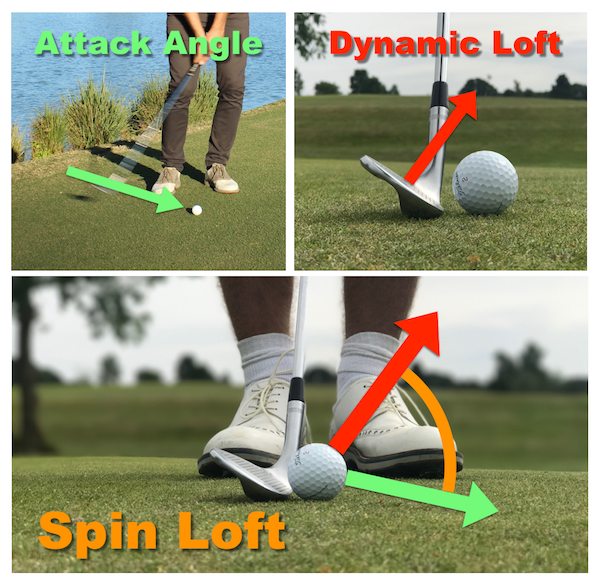To spin a golf ball, strike it with a downward angle and ensure clean contact with the ball. Use a club with loft for better spin.
Mastering the technique of spinning a golf ball can significantly improve your game. A well-executed spin allows for better control and precision, especially on approach shots and around the greens. Proper grip, stance, and swing mechanics are crucial for achieving the desired spin.
Focus on maintaining a consistent swing tempo while making sure your clubface is square at impact. Practicing these elements can help you generate backspin or sidespin effectively. Understanding the conditions, like grass type and wind, also plays a role in how the ball reacts. Regular practice and attention to detail can turn spin into a valuable tool in your golfing arsenal.

Credit: www.youtube.com
Basics Of Golf Ball Spin
Mastering the spin of a golf ball can elevate your game. It helps control distance and direction, making it vital for precision shots. Understanding the basics is the first step to becoming a better golfer.
What Is Golf Ball Spin?
Golf ball spin is the rotation of the ball after being hit. The spin type can be backspin, sidespin, or topspin. Each type affects the ball’s flight and landing.
- Backspin: The ball spins backward, creating lift and distance.
- Sidespin: The ball spins sideways, causing it to curve left or right.
- Topspin: The ball spins forward, making it roll more upon landing.
Importance Of Spin In Golf
Spin controls the ball’s behavior in the air and on the ground. It is essential for accurate shots, especially on the green. Proper spin helps the ball stop quickly or roll predictably after landing.
| Spin Type | Impact on Flight | Impact on Landing |
|---|---|---|
| Backspin | Higher and longer flight | Stops quickly |
| Sidespin | Curves left or right | Can roll unpredictably |
| Topspin | Lower and shorter flight | Rolls further |
Understanding these basics helps you control your shots better. Practice different spins to see their effects. This knowledge will improve your game strategy and performance.

Credit: www.breakfastballs.golf
Types Of Golf Ball Spin
Understanding the types of golf ball spin is essential for improving your game. Each type of spin affects the ball’s trajectory and distance. Let’s dive into the different spins: backspin, sidespin, and topspin.
Backspin
Backspin makes the ball rise and then fall sharply. This is useful for stopping the ball quickly on the green. To create backspin, hit the ball with a descending strike. This allows the grooves on the clubface to grip the ball. Ensure you have clean grooves on your club for maximum spin.
Sidespin
Sidespin causes the ball to curve left or right. This is often called a slice or hook. A slice curves to the right for right-handed golfers. A hook curves to the left. You can intentionally use sidespin to navigate around obstacles. Mis-hits can also result in unwanted sidespin.
| Spin Type | Ball Movement | Common Use |
|---|---|---|
| Slice | Curves Right | Accidental |
| Hook | Curves Left | Accidental |
| Intentional Sidespin | Curves Left or Right | Avoid Obstacles |
Topspin
Topspin makes the ball stay low and roll further upon landing. To produce topspin, you need an upward strike on the ball. This is less common in golf compared to tennis. Topspin is useful for long-distance shots on flat terrains.
- Backspin helps control distance.
- Sidespin can be intentional or accidental.
- Topspin is best for long, flat shots.
Mastering these spins can improve your overall game. Practice each type to see the effects.
Selecting The Right Equipment
Spinning a golf ball needs the right gear. Your equipment plays a crucial role. From golf clubs to the type of balls, each item matters. This section will guide you in choosing the best tools for spinning a golf ball.
Golf Clubs For Spin
Your golf club affects how much spin you can generate. Wedges are the most effective clubs for spin. They have special grooves on the face. These grooves grip the ball and increase spin. Lob wedges and sand wedges are popular choices. Choose clubs with a higher loft angle. This helps in creating more backspin.
| Club Type | Loft Angle | Spin Potential |
|---|---|---|
| Lob Wedge | 58° – 64° | High |
| Sand Wedge | 54° – 58° | Medium-High |
| Gap Wedge | 50° – 54° | Medium |
Golf Balls For Spin
The type of golf ball you use also impacts spin. Urethane-covered balls are the best for spin. They have a soft cover that grips the clubface. This results in more spin. Multilayer balls are also a good choice. They provide a balance of distance and spin. Low-compression balls can help beginners. They are easier to control and offer better spin.
- Urethane-covered balls – Best for high spin.
- Multilayer balls – Balance of spin and distance.
- Low-compression balls – Easier control and spin for beginners.

Credit: www.worldofshortgame.com
Proper Grip Techniques
To spin a golf ball effectively, mastering the proper grip is crucial. The right grip ensures better control and precision. This section will cover the key aspects of grip pressure and hand position.
Grip Pressure
Grip pressure plays a significant role in spinning the golf ball. Holding the club too tightly can hinder your ability to create spin. Conversely, a grip that is too loose can lead to a lack of control.
Follow these steps for optimal grip pressure:
- Hold the club with a light but firm grip.
- Ensure that your hands feel relaxed.
- Avoid squeezing the club too hard.
Finding the right balance in grip pressure enhances your ability to spin the ball.
Hand Position
Hand position is another crucial factor in creating spin. The correct positioning of your hands influences the clubface angle and swing path.
Consider these points for proper hand position:
- Place your left hand at the top of the grip.
- Ensure the V formed by your thumb and forefinger points to your right shoulder.
- Position your right hand below the left hand.
- Align the V on your right hand with your right shoulder.
Table of Hand Positions:
| Hand | Position |
|---|---|
| Left Hand | Top of the grip, V towards right shoulder |
| Right Hand | Below left hand, V aligned with right shoulder |
Correct hand positioning provides better control over the clubface. It allows you to generate the desired spin on the golf ball.
Mastering The Swing
Spinning a golf ball requires skill and precision. To achieve this, mastering your swing is essential. This section will guide you through the steps for perfecting your swing.
Stance And Alignment
Your stance and alignment are crucial for spinning the ball. Start by placing your feet shoulder-width apart. Ensure your body is aligned with the target. Your feet, hips, and shoulders should form a straight line.
Next, bend your knees slightly. Keep your weight balanced on the balls of your feet. Your grip on the club should be firm but relaxed. A proper stance and alignment set the foundation for a good swing.
Swing Path
The swing path greatly affects the spin. Begin with a smooth takeaway. Your club should move straight back along the target line.
During the downswing, focus on an inside-out path. This means the club should approach the ball from inside the target line. An inside-out path helps generate spin.
Finally, make contact with the ball. Strike it with a descending blow. This creates the desired backspin effect. Follow through with your swing, maintaining control and balance.
| Key Element | Description |
|---|---|
| Stance | Feet shoulder-width apart, knees slightly bent, balanced weight. |
| Alignment | Body aligned with target, straight line formation. |
| Swing Path | Smooth takeaway, inside-out downswing, descending blow. |
- Stance: Feet shoulder-width apart.
- Alignment: Body aligned with target.
- Takeaway: Move club straight back.
- Downswing: Inside-out path.
- Contact: Descending blow for spin.
Impact And Ball Contact
Understanding impact and ball contact is crucial for spinning a golf ball. The way you strike the ball influences its spin. This section will delve into the key aspects of impact and ball contact.
Clubface Angle
The clubface angle plays a significant role in generating spin. To create spin, the clubface must be slightly open or closed. An open clubface adds more backspin, while a closed face produces sidespin.
- Open clubface: more backspin
- Closed clubface: more sidespin
Ensure the clubface aligns with the desired spin direction. Misalignment can lead to unwanted ball flight.
Hitting The Sweet Spot
Hitting the ball on the sweet spot maximizes spin. The sweet spot is the center of the clubface. Striking here reduces energy loss and increases control.
To consistently hit the sweet spot, practice your swing. Focus on your grip, stance, and alignment.
| Aspect | Tip |
|---|---|
| Grip | Hold the club firmly but not too tight |
| Stance | Stand with feet shoulder-width apart |
| Alignment | Align your body with the target |
Practicing these elements will help you hit the sweet spot more often. This leads to better spin control and improved shots.
Practice Drills
Mastering the art of spinning a golf ball requires consistent practice drills. These drills focus on chipping, pitching, and full swings. Practice helps improve control and accuracy. Below are some targeted drills to help you get started.
Chipping And Pitching Drills
Chipping and pitching are essential for short game control. Practice these drills to gain better spin and precision:
- Short Grass Drill: Place a ball on short grass. Use a wedge to chip the ball. Focus on hitting the ball cleanly.
- Backspin Drill: Place the ball slightly back in your stance. Hit down on the ball with a steep angle. This creates backspin.
- Target Practice: Set up targets at different distances. Practice chipping and pitching to these targets. Aim for consistency.
Full Swing Drills
Full swings need precision for ball spin. These drills help you perfect your swing and spin:
- Impact Position Drill: Focus on your impact position. Ensure your hands are ahead of the ball at contact.
- Divot Drill: Take a divot after hitting the ball. This indicates a clean strike, crucial for spin.
- Spin Control Drill: Experiment with different clubs. Notice how each club affects ball spin.
| Drill | Description | Focus Area |
|---|---|---|
| Short Grass Drill | Chip ball from short grass | Clean hit |
| Backspin Drill | Hit down steeply on the ball | Backspin creation |
| Impact Position Drill | Ensure proper hand position | Impact control |
| Divot Drill | Take a divot post-impact | Clean strike |
Common Mistakes To Avoid
Spinning a golf ball can be tricky. Many golfers make common mistakes. These errors can affect your game. Let’s look at some common mistakes to avoid.
Overcompensating Spin
Overcompensating spin can ruin your shot. Many golfers try to add too much spin. This can cause the ball to veer off course. It’s important to strike a balance.
- Use a balanced grip.
- Do not twist your wrists too much.
- Focus on a smooth, controlled swing.
Practice helps you avoid overcompensating. Keep your movements natural. This will help you gain better control.
Incorrect Ball Position
Incorrect ball position is another common mistake. The ball’s position affects the spin. Placing it too far forward or backward can cause issues.
| Position | Effect |
|---|---|
| Too Far Forward | Reduces backspin, increases roll |
| Too Far Back | Increases backspin, decreases roll |
Position the ball correctly. This helps you achieve the desired spin. Always check your stance.
In summary, avoid overcompensating spin and incorrect ball position. These tips will help you spin the golf ball effectively.
Frequently Asked Questions
How Do You Get Spin On A Golf Ball?
To get spin on a golf ball, strike it with a downward angle. Use a lofted club and ensure clean contact.
How To Backspin A Golf Ball With A Wedge?
To backspin a golf ball with a wedge, use a lofted club, strike downward, and hit the ball cleanly. Ensure the clubface is clean, and apply maximum speed. Maintain a firm grip and follow through properly. This technique generates the necessary spin for backspin.
Practice to master control and consistency.
How To Put Backspin On A Golf Ball When Chipping?
Use a lofted club and strike the ball cleanly. Position the ball back in your stance. Ensure a downward strike. Maintain a smooth follow-through. Practice consistently for better results.
How To Get More Backspin On Irons?
Use a clean, dry clubface and premium golf balls. Strike down on the ball with a steep angle. Maintain a consistent swing speed.
Conclusion
Mastering the art of spinning a golf ball can enhance your game significantly. Practice these techniques regularly for better control. Remember, patience and consistency are key. Utilize the tips shared in this guide to improve your skills. Soon, you’ll notice a remarkable difference in your golf performance.
Happy golfing!
How to Spin a Golf Ball





